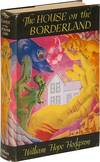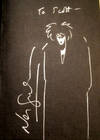
Opticks: or, A Treatise of the Reflexions, Refractions, Inflexions and Colours of Light.: Also Two Treatises of the Species and Magnitude of Curvilinear Figures.
by NEWTON, Isaac
- Used
- Hardcover
- first
- Condition
- See description
- Seller
-
London, United Kingdom
Payment Methods Accepted
About This Item
London: printed for Sam. Smith, and Benj. Walford, Printers to the Royal Society,, 1704. Newton defines colour through mathematics First edition, first issue, without the author's name on the title page. Newton's Opticks expounds his corpuscular theory of light and summarizes his experiments concerning light and colour. It also prints two important mathematical treatises (omitted in later editions) describing his invention of the fluxional calculus, the grounds for his claim of priority over Leibniz. Newton arrived at most of his unconventional ideas on colour by about 1668, and Opticks was largely complete by 1692. However, when he first partially expressed his theories in public, in 1672 and 1675, they provoked hostile criticism, especially on the continent. As a result, Newton delayed the publication of Opticks until his most vociferous critics - especially Robert Hooke - were dead. Unusually for Newton, and in what was probably a further defensive move, the work was first published in English rather than Latin, becoming a major contribution to the development of vernacular scientific literature. By about 1715, Opticks established itself as a model for interweaving theory with quantitative experimentation. Newton's aim was not to "explain the properties of light by hypotheses, but to propose and prove them by reason and experiments" (p. 1). The great achievement of the work was to show that colour was a mathematically definable property. Newton demonstrates that white light is a mixture of infinitely varied coloured rays (manifest in the rainbow and the spectrum) and that each ray is definable by the angle through which it is refracted on entering or leaving a given transparent medium. "Newton's Opticks did for light what his Principia had done for gravitation, namely place it on a scientific basis" (D. W. Brown, cited in Babson). Other topics discussed in this groundbreaking work include the degree of refraction associated with different colours, theories of the rainbow, colour circles, Newton's rings, and reflective lenses. Provenance: from the distinguished library of the Northern Lighthouse Board, with their device stamped on the spine. The board was founded in 1786 to remedy the fact that none of the major passages through dangerous narrows in Scotland were marked. Headed by the Stevenson family of engineers - of which novelist Robert Louis Stevenson was a member - the Board embarked upon an ambitious construction scheme and still operates over 200 lighthouses today. This volume, along with a portion of their library - with strong holdings across the applied sciences, exploration, maritime, and local geography - was offered at auction in 2010 to raise funds for heritage projects. Quarto (233 x 186 mm). Late 19th-century tan calf, spine divided into 6 compartments with raised bands and gilt fillets, Northern Light Board device gilt-stamped to first, black calf label to second, gilt scrollwork motifs to remainder, covers framed with triple fillet in blind, red and blue sprinkled edges. 19 engraved plates, of which 2 folding, charts and diagrams within text, title page printed in black and red within double-ruled border. Extremities rubbed, a few minor marks to calf but presenting handsomely, endleaves browned from turn-ins and initial blank browned facing title page, contents and plates lightly foxed in places but generally clean, with a few finger marks and pencilled annotations in margins, intermittent faint damp stain at lower outer corners, some plates a little trimmed in the binding process (just touching a few captions and images), thin paper stock of Nn4 resulting in short closed tear at fore edge expertly repaired. Overall a crisp, bright copy in a very smart calf binding. Babson 132 (1); ESTC T82019; Gray 174; Horblit 79b; Norman 1588; Printing and the Mind of Man 172.
Reviews
(Log in or Create an Account first!)
Details
- Bookseller
- Peter Harrington
(GB)
- Bookseller's Inventory #
- 167443
- Title
- Opticks: or, A Treatise of the Reflexions, Refractions, Inflexions and Colours of Light.
- Author
- NEWTON, Isaac
- Book Condition
- Used
- Binding
- Hardcover
- Place of Publication
- London: printed for Sam. Smith, and Benj. Walford, Printers to the Royal Society,
- Date Published
- 1704
Terms of Sale
Peter Harrington
All major credit cards are accepted. Both UK pounds and US dollars (exchange rate to be agreed) accepted. Books may be returned within 14 days of receipt for any reason, please notify first of returned goods.
About the Seller
Peter Harrington
Biblio member since 2006
London
About Peter Harrington
Since its establishment, Peter Harrington has specialised in sourcing, selling and buying the finest quality original first editions, signed, rare and antiquarian books, fine bindings and library sets. Peter Harrington first began selling rare books from the Chelsea Antiques Market on London's King's Road. For the past twenty years the business has been run by Pom Harrington, Peter's son.
Glossary
Some terminology that may be used in this description includes:
- First Edition
- In book collecting, the first edition is the earliest published form of a book. A book may have more than one first edition in...
- Edges
- The collective of the top, fore and bottom edges of the text block of the book, being that part of the edges of the pages of a...
- Crisp
- A term often used to indicate a book's new-like condition. Indicates that the hinges are not loosened. A book described as crisp...
- Spine
- The outer portion of a book which covers the actual binding. The spine usually faces outward when a book is placed on a shelf....
- Quarto
- The term quarto is used to describe a page or book size. A printed sheet is made with four pages of text on each side, and the...
- Device
- Especially for older books, a printer's device refers to an identifying mark, also sometimes called a printer's mark, on the...
- Title Page
- A page at the front of a book which may contain the title of the book, any subtitles, the authors, contributors, editors, the...
- Foxed
- Foxing is the age related browning, or brown-yellowish spots, that can occur to book paper over time. When this aging process...
- Gilt
- The decorative application of gold or gold coloring to a portion of a book on the spine, edges of the text block, or an inlay in...
- Fore Edge
- The portion of a book that is opposite the spine. That part of a book which faces the wall when shelved in a traditional...
- Remainder
- Book(s) which are sold at a very deep discount to alleviate publisher overstock. Often, though not always, they have a remainder...
- Raised Band(s)
- Raised bands refer to the ridges that protrude slightly from the spine on leather bound books. The bands are created in the...
- Calf
- Calf or calf hide is a common form of leather binding. Calf binding is naturally a light brown but there are ways to treat the...








